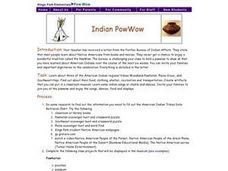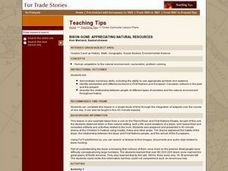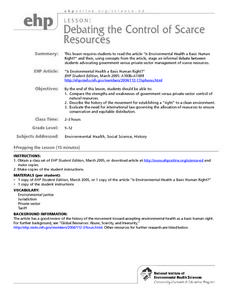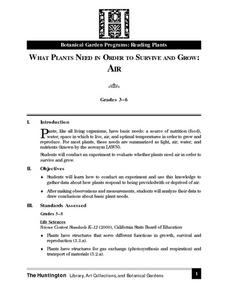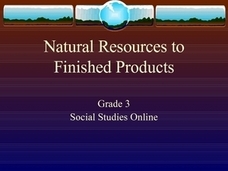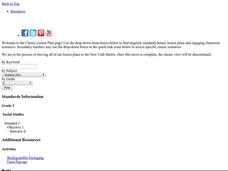Curated OER
Indian PowWow
Students identify three different American Indian regions and tribes, their food, clothing, shelter, recreation, and transportation. Students create artifacts that can be placed in a museum. Students sing songs, chants, and dance. ...
Curated OER
Salmon Vs. Dams: the Dam Removal Debate on the Elwha River
Students role-play a meeting of the Elwha River council in which they present opposing views to council members on hydroelectric power and salmon fisheries resources. They brainstorm possible conflicts between various people in land-use...
Curated OER
Old Solutions - New Solutions
Learners examine descriptions of a mining company's land-reclamation project. They share information to analyze the environmental impact of the project. Independently, they answer questions on environmental and economic issues...
Curated OER
Popcorn Geography
Students use kernels to create a "Top Corn-Producing States" map or graph. They read and round off numbers. Students identify on a U.S. outline map the location of corn-growing states. They create a visual (map or graph) illustration...
Curated OER
Is That Natural?
Students examine how they use and waste natural resources. They participate in a class discussion about natural resources, in small groups complete a worksheet identifying ways students misuse natural resources, and create an...
Curated OER
Design a Recycling Game!
Students discover that recycling is using a product more than once so that natural resources can be saved and so that we won't need so many garbage dumps and landfills. They see that there are different ways to recycle. Students design a...
Curated OER
Case Study - Tragedy of the Commons
Students role play being a fisherman and fulfill the goals they are given from a description sheet. Other students observe the fisherman and record their behavior and actions. The class then discusses how this activity was an example...
Curated OER
Bison Gone: Appreciating Natural Resources
Students examine the effects of the loss of the bison after the Europeans arrived in North America. They conduct a demonstration using beans to demonstrate the difference between the number of bison before and after the arrival of the...
Curated OER
Energy Sources
Students identify natural resources and describe the difference between renewable and non-renewable resources. They also identify the disadvantages and advantages of the resources.
Curated OER
Debating the Control of Scarce Resources
Students examine the issue of government versus private sector control of natural resources. They read an article, evaluate the need for international law governing resource allocation, and participate in a class debate.
Curated OER
Global Resources: What Will You Do with Your Power?
Students examine the human impact on natural resources. They read and discuss an article, evaluate nations regarding their environmental problem-solving, develop a presidential speech on the environment, and conduct a natural resources...
Curated OER
What Plants Need in Order to Survive and Grow: Air
Young scholars conduct an experiment to determine whether plants need air in order to survive and grow. They discuss natural resources, analyze slides, and observe and record data from the experiment.
Curated OER
The Energy Grab Game
Eighth graders explore the scarcity of energy resources. They also explore the competition for natural resources and the inadequate distribution of natural wealth among the Earth's nations.
Curated OER
Use Or Abuse?
Learners explain the meaning of "use value" of nature's resources by researching and writing studenT books personifying an aspect of nature. They produce public service announcements regarding use value for their local community.
Curated OER
Create a Country
Young scholars work in small groups to list features and elements found on a variety of grade- appropriate maps. They develop a class list of map features and elements to draw from as they create a map of an imaginary country.
Curated OER
Where's the Drip?
Students detect water leaks. In this water conservation ecology lesson, students take a tour of the school grounds and identify sources of water and possible leaks. Students report leaks to the custodian and administration.
Curated OER
They're Tilling that Field Behind the Mall
Unfortunately, the article for which this resource was written is not available. You can, however, find another current document on agriculture and urban development for your class to read together, and then still follow the suggested...
Curated OER
Tale of a Tuna
Junior marine biologists access the International Commission for the Conservation of Atlantic Tunas' data on Atlantic Bluefin Tuna catches. As they analyze the data, they answer three questions. Background information and links to...
Curated OER
Natural Resources to Finished Products
This PowerPoint provides definitions and related illustrations for "natural resources," "renewable resources," and "non-renewable resources." Instructions for a classroom activity locating resources is included.
Pennsylvania Department of Education
Wind and Water Wheels
Students identify wind and water as natural resources that create energy. In this natural resources and energy use lesson, students work in groups to construct a pinwheel, then explore the effects of wind and water on the pinwheel....
Curated OER
Corn An A-Maizing Plant
Fifth graders consider the uses of corn. In this agricultural lesson, 5th graders examine corn as a natural resource and discuss the many ways to reuse the grain. A variety of activities, books, and web resources are included...
Curated OER
Now You Have It, Now You Don't
Fifth graders explore the value of service. In this consumer practices instructional activity, 5th graders investigate natural resource protection needs. Students participate in the preservation of natural resources through service...
Curated OER
Source Search
Pupils discuss the sources of items they use everyday. In this social studies lesson, students sort pictures of items used everyday by their source. Pupils participate in a source relay.
Curated OER
Tree-mendous!
Fifth graders identify the ways people use trees. In this Science lesson, 5th graders play a word game with tree classification. Students determine the need for protecting natural resources.
